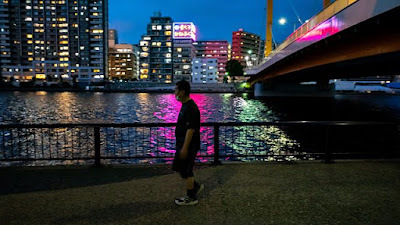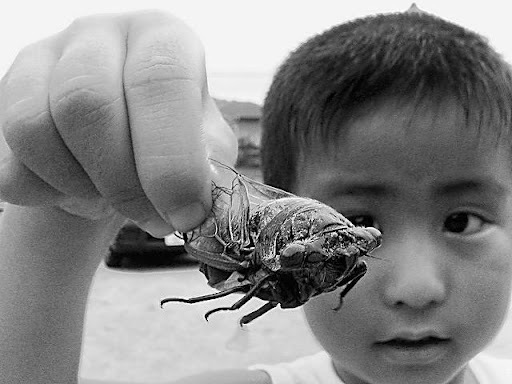Roland Kelts's Blog, page 10
November 30, 2021
December 8th: The 50th Anniversary of "The Inland Sea" by Donald Richie
"The Inland Sea" by Donald Richie is among the finest books ever written about Japan (some would say it's the finest) and we're celebrating its 50th Anniversary on DEC. 8th with a live Zoom event. I'll be discussing the book with renowned Japan scholar John Nathan, translator of Mishima, Oe, Soseki and others, and a great filmmaker to boot. Our talk will be moderated by Peter Grilli, president emeritus of The Japan Society of Boston. Registration is free here.

The book is still in print, beautifully so, and will be sold at discount during the event by Stone Bridge Press. Please join us for this landmark evening hosted by The Japan Society of Boston. I'm really looking forward to this one.
November 11, 2021
My story about "Blade Runner: Black Lotus," the first-ever anime series in the Blade Runner canon
‘Blade Runner: Black Lotus’ reinvents neo-noir nods to Japan
When the first anime series in the “Blade Runner” franchise premieres on cable TV’s Cartoon Network and online streamer Crunchyroll Nov. 13, it will close the circle on nearly 40 years of cultural cross-pollination.
British director Ridley Scott’s 1982 original, a Hollywood live-action movie set in a futuristic Los Angeles, features several neo-noirish nods to a dystopian urban Japan. Signs in Japanese flash above neon-lit alleyways lined with cramped standing food stalls. Snatches of Japanese dialogue are heard on the streets and from the radio in Los Angeles police officer Gaff’s hovercraft (the brilliantly designed “spinner”), and in the voiceover accompanying an indelible image of a geisha, popping a pill on a gigantic skyscraper video projection.

Even today, seeing Japanese culture embedded so deeply in the mise-en-scene of a mainstream Hollywood film is startling. In 1982, it must’ve been revolutionary.
It didn’t go unnoticed in Japan. While “Blade Runner” was not a box-office hit on either side of the Pacific, it was revered by those who understood its heady blend of sleek high-tech environs with low and grimy street culture, a visual icon of the emerging cyberpunk sci-fi subgenre.
Over time, “Blade Runner” was tagged as a “cult classic.” And oh, what a cult it was, particularly in Japan.
A generation of anime artists was shaped by the film’s daring and gritty aesthetic, and would go on to create some of Japan’s consecrated anime classics such as “Akira,” “Ghost in the Shell” and “Cowboy Bebop” — titles that are now so popular and renowned that they have been or are being remade in Hollywood. Talk about circles.
“Akira” director Katsuhiko Otomo and “Ghost in the Shell” director Mamoru Oshii have both cited “Blade Runner” as a key source of inspiration for their conceptual designs, and “Cowboy Bebop” creator Shinichiro Watanabe has seen Scott’s film over 20 times.
“It was the feel of the world in ‘Blade Runner’ that surprised me the most,” Watanabe says, commenting on the film’s mix of futuristic surrealism and grim urbanism. “With ‘Star Wars,’ the story takes place in a world different from where we actually live. But ‘Blade Runner’ takes place in our reality, and the visual design is so cool in every scene.”
In 2003, Hollywood and anime had their first successful cross-pollination project with “The Animatrix,” a collection of animated short films by Japanese artists based on the Wachowskis’ “The Matrix,” which was itself an homage to sci-fi anime, particularly “Ghost in the Shell.” The commercial and critical success of “The Animatrix” omnibus DVD collection, to which Watanabe contributed two short films, led to a growing feeding frenzy over Hollywood-anime remixes, resulting most recently in “Star Wars: Visions,” released Sept. 22 on Disney’s streaming platform.
The frenzy didn’t mean much to Watanabe, who declined time and again to adapt Hollywood films to anime, preferring to create his own original works. But he couldn’t refuse when an opportunity to expand upon the “Blade Runner” world arrived in 2017, courtesy of producer Joseph Chou, founder and president of Tokyo-based CG anime studio Sola Digital Arts Inc. Watanabe was invited to create one of three short films introducing the franchise’s live-action sequel, “Blade Runner 2049.”
Watanabe’s short “Black Out 2022” is a fitting precursor to the forthcoming series, “Blade Runner: Black Lotus.” Its Los Angeles cityscape is on fire. Cars burn in the streets, riots run amok. Databases identify the undesirables: dolls, replicants, anyone not like “us.” Its hero is a Black man, Iggy, and his counterpart is a young female replicant. They have been used and exploited by institutional power, and now they are ready to rebel.
“Human history is a history of discrimination against weaker people,” Watanabe says. “I needed to show that.”
Capturing and re-creating that discrimination while making the design look cool in “Black Lotus” was the job of the multinational creative team at Chou’s Tokyo studio, where anime remixes of legacy titles like “Lord of the Rings” and “Ultraman” are currently in the works.
Watanabe signed on as the creative producer, but veteran directors Shinji Aramaki and Kenji Kamiyama helmed the series, bringing together artists and production companies from Japan, Asia, Europe and North America.
This time, the lead “Blade Runner” character is Elle, a young woman with Asian features and martial arts fighting skills. Her environs shift between the California desert and burning LA skyline, and her best friend is the meek but reliable Miu. Both are replicants and subject to discrimination and assault. Their human ally is a dissolute programmer named Jay, who behaves in a distinctly Japanese manner.

“Jay definitely feels more Japanese in personality,” Kamiyama tells me. “He treats Elle with a classic naniwa bushi spirit of loyalty, duty and compassion. He’s kind of a kakkoii (cool, reserved) character. Like Ken Takakura in ‘Black Rain,’ he’s brooding and dark. Scott used Takakura for that kind of quiet figure, who acts a little rogue but inside his mind and his heart is always thinking of the other, always considerate.”
As an animated series, “Black Lotus” is the next step in a nearly 40-year-old franchise that still commands respect. Some anime fans, however, are suspicious of the current pile-on of Hollywood studios gunning for transcultural collaborations. Is anime all about money now?Chou insists that there’s a way of creating such projects while maintaining the integrity of Japan’s anime traditions. Competing with Hollywood is a doomed scenario: CG costs money, and anime studios operate on much smaller budgets. But if you can’t make CG properties, how can you make something fresh?
“‘Black Lotus’ is the first project where we tried to tackle the dilemma of making cheap CG and awesome 2D anime,” Chou says. “What’s the balance here visually?”
On a visit to Sola’s Tokyo studio, I watched artists from France, the Middle East and Japan spend hours fixing the look of steam rising from a city rooftop in the “Blade Runner” universe. “The city is the character,” Chou says. “We can achieve that, and we can grow the story.”
“Black Lotus” closes the circle in 2021 by reinventing the Los Angeles of the original “Blade Runner” — with its neon Japanese signs, noodle stalls, pill-popping geisha and all — at an anime studio in downtown Tokyo.
“Blade Runner: Black Lotus” will be available worldwide on Crunchyroll from Nov. 13. Roland Kelts is the author of “Japanamerica: How Japanese Pop Culture has Invaded the U.S.” and a professor at Waseda University.
November 9, 2021
Video: Interview on the 50th Anniversary of "Lupin the 3rd" with author and historian Charles Solomon
This was a whole lot of serious fun: My roundtable chat with author, historian, and dear friend Charles Solomon to commemorate the 50th Anniversary of the "Lupin the 3rd" anime franchise, one of the world's longest-running animated series. Of course we talked a lot about "The Castle of Cagliostro," Hayao Miyazaki's first feature film as director, a charmed and stunning work that is often a gateway for non-Japanese to the Lupin universe.
Our roundtable is for Sentai Filmworks and TMS Entertainment.
November 4, 2021
My fifth "Letter from Tokyo" for The Japan Society of Boston

LETTER FROM TOKYO, OCTOBER 2021: GINGKO GOLD
September still feels like late summer in Tokyo, with stretches of sunbaked days and lingering cicadas and humid stillness. But by October the air crispens and the leaves go vibrant. October coaxes forth the city’s magnificent foliage, blanketing its far-flung hillsides and spreading colorful canopies across its parks and university campuses.
This year, the humidity got siphoned away overnight and evenings grew chilly fast. But for someone like me, raised in the northeastern US and north-central Japan, the shift to windbreakers and warmer bedclothes is welcome. Wherever I am, that transition in temperature feels like home.
Speaking of overnight: Have any other Olympic Games dissipated so quickly? No disrespect to the athletes, medalists and their retinue, but the 2020 Tokyo Olympic Games, held less than three months ago in 2021, almost feel more ancient today than the first Tokyo Olympics in 1964.
Things here have changed, and not just the weather.
After a slow and chaotic vaccine rollout last spring, the percentage of Japan’s fully vaccinated now exceeds that of the US. Tokyo’s daily tally of Covid infections is at an 11-month low. At least some of the city’s surviving izakayas, bars and restaurants and many commuter trains are slowly being replenished. And the whole country has a brand new Prime Minister.
In short, this is an auspicious autumn in Tokyo. The Olympics and the wilting humidity are gone, Covid has been tamed (at least temporarily)—and the biggest crisis in the media now revolves around an imperial suitor with a tacky ponytail. This October, the entire city feels like a sigh of relief.
It’s a good time to sigh. Partly owing to my years in academia as a student, teacher, professor and general hanger-on, autumn always feels to me like the true start of a new year, far more than January or February or the onset of spring. In the cities I’ve lived in, primarily Tokyo, New York, London and Boston, the air turns crystalline, “severe clear,” as my friend, the writer Paul Elie, told me during our long walk through lower Manhattan on the 20th anniversary of 9-11.
The breezes perk you up and demand a response. The sunlight sharpens the edges of things. The big new books and movies are released ahead of the holiday season, Broadway’s major shows open, restaurants update their menus. Some will feel like second homes when winter takes hold.
As Rilke wrote about facing true beauty in his poem on the torso of Apollo: “there is no place that does not see you / you must change your life.”
And so every Autumn I usually do, or at least I try to make changes. Some of them are small and may look trivial: haircuts, exercise routines, altered habits and new clothes, books and writing and travel.
This year I’m entering a zone of what I think of as pure writing, trying to revive the yearning that drove my first written words. All summer I’ve been reading my old notebooks, short stories, letters, poems and songs. It’s been quite an encounter, a confrontation. Who wrote that stuff? Who are you?
To me, autumn in Tokyo is golden. Gingko gold. Though the trees actually bloom in late-November into December, they flame in my mind as bright signatures of fall across the city’s sky.
I’m walking across the Komaba campus of the University of Tokyo, where I taught for several years, and the yellow leaves pierce the pristine blue above with a delicate urgency. I start to walk faster, write more, trim down and simplify.
You must change your life.
November 2, 2021
Audio: Interview on "What's Ailing Japan?" for the BBC

I was interviewed by the BBC for a smart show about Japan's post-Olympic doldrums and political ossification. Many of the questions were excellent, and I was honored to appear alongside Sophia University prof Koichi Nakano, Seijiro Takeshita from the University of Shizuoka, and SOAS University of London scholar Sarah Parsons.
Now that the election is over and the LDP firmly back in control, this panel feels prophetic.
Audio is here:
October 8, 2021
My fourth "Letter from Tokyo" for The Japan Society of Boston

LETTER FROM TOKYO: Cicada cry
I caught cicadas in my grandparents’ garden when I was five years old. This was in Morioka City in August, the first full month I lived in Japan before attending kindergarten.
It was hot. I used a lightweight long-necked net to capture them and kept them in a green plastic cage my grandfather had bought for me. The cicadas seemed huge and powerful and I loved looking into their eye bulbs with the little black dots in the middle.

When you held them from behind by the tips of their wings, their legs clawed at the air then stopped. Their faces looked like they could have been dangerous insects, biting or stinging, but at the last minute decided not to be. So they just stared back at you.
There is the famous Basho haiku about cicada cries hiding the nearness of their death but I didn't know anything about that then. I just loved their eyes and wings and the perfect ghost husks they left behind, clinging to the trees as if they were still alive inside.
Through my teens, August often meant a two-week trip to Japan with my mother. Summer vacation for American kids is nearly three months but for Japanese kids it’s one: August. My mother took me in August so I could meet some Morioka students on summer break and speak English with them at my grandparents’ house.
As I got older, I complained about the trips. In the US, August meant time to practice drumming with my high school rock band and go on walks down the railroad tracks with my one good friend and read ghost stories in the library. I didn't want to lose that time by being in Japan. But I always went.
Years later, my first full month living in Japan as an adult without my mother was also an August. I lived in Osaka. A friend of my mother’s family, my age, took me to Kyoto to see the Daimonji Festival, with its huge fire kanji characters burning in the mountains at night on three sides of the city, guiding ghosts back to heaven. We were mashed together in a thick crowd and sweated so much it felt like swimming in air. The cicadas buzzed and sizzled all around us. Their sound made the heat and fires feel urgent.
I've now lived in Tokyo for over twenty years. These days I spend most of August indoors, surrounded by books and notebooks and the whisper of a wall-mounted air conditioner. But a few times during each day I'll slide open the glass and screen doors and step onto the balcony to feel the unconditioned air and sunlight, to remind myself that they're natural and real and should be a part of me. I try to read outside until I sweat out everything toxic (or so I fantasize), soaking my shirt and the creases of my shorts, or until I get so drowsy and fatigued by the humidity that I can't comprehend words anymore and keep re-reading the same paragraph.
The cicadas cry from the sparse trees and thickets nestled between Tokyo apartment blocks, still potent, urgent. I no longer catch them with a net but in their sound I can hear the desperation Basho was writing about. I feel it, too.
September 8, 2021
Video: Interview for TRT on "Japanamerica," "Yasuke" and racial representation in Japan
August 24, 2021
My third "Letter from Tokyo" for The Japan Society of Boston

LETTER FROM TOKYO, JULY 2021: THE GAMAN GAMES
One hot July day I was invited to give a TED Talk in Tokyo about “Japanamerica” and “Cool Japan,” the government’s campaign to capitalize on the international appeal of Japanese popular culture. But I didn't feel cool at all, and I didn't want to speak again about manga and anime, so instead I gave a talk about gaman: the virtue of enduring adversity with patience and dignity, and without whining.
Every July in Tokyo puts gaman to the test. The rainy season evaporates and the sun reclaims the sky, blasting over the city’s concrete with a vengeance. Tsuyu’s misty speckles on your brow turn to smears of sweat. Venturing outside of your air-conditioned cave is a trial. And after only a few 100-degree days, you know you're in trouble when sitting on your veranda at midnight feels nearly as stultifying as a lunch-hour stroll at high noon.
This July, Tokyo has the added trials of a fourth Covid-19 “state of emergency” until September, a belated and halting vaccine rollout, and tens of thousands of visiting athletes, coaches and media reps pitching tent in town for two months. Olympic and paralympic-sized trials, indeed.
In the Western media, a lot has been made of residents protesting the staging of the Olympics mid-pandemic. But where I live, such protests have been thinly attended, and mostly by the usual suspects: older, ANPO-generation retirees bearing the signs and ritual chants of the habitually self-righteous, and younger student-age marchers taking a breather from Twitter rants by snapping selfies to accompany and enliven those rants.
Compared to New York or London, two other cities I've lived in, the outrage looks tame. There are even police escorts, dutifully obeyed, and not a single instance of the violent “kettling” crowd-control tactic, used by many urban police departments to divide-and-conquer civilians by cornering and assaulting them.
Instead, most Tokyoites seem resigned to grin and bear it, or grit their teeth and bear it, to gaman their way through the Games just as they do every July’s heat and humidity, periodic typhoons, skittering cockroaches and chainsaw cicada buzz.
Only this year, while the Olympics are on, August has been canceled for the second summer running. Next month’s giddy matsuri festivals and eye-popping fireworks displays and homecoming pilgrimages to O-bon gatherings will all be missing, nixed once again to preserve social distancing and prevent infection.
The days will pass hot and oppressive as always, but the sweet relief and release of dancing in the streets around bobbing mikoshi shrines and sweating through your creased yukata folds surrounded by friends and family as the skies boom and crackle with color and eating greasy treats from yatai food stalls while you drink yourself silly and sleepy in the thick summer air—none of that will come to pass.
And that makes gaman feel especially trying this July, worthy of real outrage, even protest. For whatever their outcomes, the games will end. The athletes and camera crews will pack up, board flights, go home. But here in Tokyo, August feels over already. The normal of enduring a long hot Japanese summer surging together with your neighbors in time-honored bursts of celebratory joy is still such a long way away.
August 14, 2021
My feature story on VTubers
Japan’s virtual YouTubers have millions of real subscribers — and make millions of real dollars
How the pandemic mainstreamed VTubers, Japan's fictional YouTube celebrities.
Rest of World/Kizunaai
By ROLAND KELTS
Virtual YouTuber Kizuna AI is the featured guest on Downtown DX, a decades-old prime-time variety show hosted by two of Japan’s most famous veteran comedians, Hitoshi Matsumoto and Masatoshi Hamada. Both pushing 60, the boomers joke about not knowing who or what she is, feigning ignorance. “What is this?” they ask, peering at the kinetic anime graphic, its eyelashes fluttering. “Who’s in there?”
But AI gets the last laugh. “Do you even know about us?” Matsumoto asks her, or the screen on the floor of the soundstage where she is manifesting today. “Of course I do!” AI replies in her squeaky chirp, spreading her arms, brushing away the question. “I know everyone here.” Then she beats one of the hosts at an impromptu game of rock-paper-scissors. “Do something now!” she shrieks at him after she wins. “Make some kind of reaction," she says, "Look that way! Look up! Look down!” giggling hysterically as the human Matsumoto obeys like a robot.
In contrast to her paunchy, middle-aged hosts, AI’s physique is archetypal shōjo (young female) manga: long legs and hair, short skirt, with a prim schoolgirl bow across her chest and a pink hairband with heart-shaped bunny-ear patterns on her head. Her gestures, expressions, and energy are otherworldly, less realistic than hyperreal, like watching a Technicolor character from a cartoon dancing around a black-and-white room. When she’s bantering with human celebrities and hosts on talk shows, AI’s glowing, unblemished presence makes her the most charismatic star on the screen. Everyone else looks drab, no matter how famous they are.

She was made to be so. Her full name puns on ai, the Japanese word for “love,” combined with the acronym for artificial intelligence and roughly translates as “bonds of love.” A single actor provides her voice, but her movements and reactions are computer generated, with her comments chirped by the performer in real time. Her precision-point kawaii looks and air-brushed, super-cute sexiness were crafted by illustrator En Morikura.
Launched in 2016, Kizuna AI was the first genuine “VTuber,” an entirely digital YouTube celebrity — not an avatar for a real person but wholly animated and autonomous. “Yes, there’s an actor rumored to provide her voice, named Nozomi Kasuga,” her creator, Takeshi Osaka, CEO and founder of production company Active8 Inc., says. “But no one really cares or wants to know. AI’s like Mickey Mouse. Who cares who does the voice?”

On June 30, AI and the VTuber phenomenon she spawned turned five years old. But over those years, she’s become a trans-media phenomenon, an AI character who is functionally interactive in a variety of real and virtual settings. This year, she modeled a collection for the fashion company Valentino, graced a recent cover of Japan’s glossy Commons&sense magazine. She’s shilled for telecoms giant SoftBank and the Japan National Tourism Organization, among others. She’s performed two live concerts on YouTube, TikTok, China’s Bilibili, and VR platform Oculus Venues. For her birthday celebration, she performed for the first time with a live human band at Tokyo’s Zepp Haneda music hall. Front-row tickets cost $150 each.
Before the coronavirus pandemic forced the world into internet isolation in 2020, VTubing was a niche medium, largely confined to Japan’s overactive subculture of fanboys and otaku. The pandemic’s disruptions to everyday lives, and to the entertainment industry, have broadened VTubing’s appeal. Last August, Playboard, the YouTube financial stats aggregator, reported that seven of the world’s 10 top Super Chat earners were Japanese VTubers. (YouTube launched Super Chat in 2017, allowing users to pay to have their comments highlighted and pinned to the top of live chats during streams.) The comically endowed, auburn-haired and horn-eared dragon avatar Kiryu Coco led the way at over $800,000 total, drawing more than $100,000 in a single week. In a year without concerts, conventions, or even café meetups, fans worldwide flocked to virtual entertainment. VTubers, far less virus prone than old-school flesh-and-blood YouTubers, surged in popularity. According to YouTube’s Culture and Trends report, by October 2020, VTubers’ views grew to more than 1.5 billion per month.
“The pandemic created a new digital ecosystem of livestreaming homebodies,” says 28-year-old Meilyne Tran, a VTuber fan and COO of GeeXPlus, a Tokyo-based anime YouTuber management company, a subsidiary of the Japanese publisher and producer Kadokawa Corp. “The attraction to VTubers is because they’re not human, not in spite of it,” she says. “People of my generation don’t like humans so much nowadays. We’re plugged in all the time and prefer interacting online, and VTubers keep us in the fantasy universe.”
Shown here, a Rest of World editor interacts with a female figure through face tracking on an iPhone and the VTube Studio app, a popular platform for VTubers. VTube Studio. Modeling: Live2D Inc. Illustration: Kani Biimu.Ivan — who asked me not to use his full name, to protect his privacy — was born in Bulgaria but moved to his mother’s native Japan a little over three years ago. He used to follow a handful of YouTubers and Twitch influencers and gamers, but sometime during the pandemic he switched to virtual entertainment, after he got sick of “thirst traps” and “e-thots” (electronic that ho over theres) — people who post photos or host video streams that lure viewers in with their bodies, only to take their money and rebuff them when they try to build a relationship.
“Real women with hot bodies are always showing off, getting naked in a bathtub or little swimming pool, trying to get you to lust after them,” he explains. “They don’t really care about you. They just want your money. A lot of people have gotten their hearts broken by 3D women on streaming, but with a 2D character, she can’t really break your heart. You don’t really know what she looks like, you just see this cute anime girl with this really cute voice.”
After attending two years of study at a college in Japan, Ivan lucked into a job as a part-time staffer at a Japanese VTuber agency and says he’s so busy producing and watching VTuber livestreams, he no longer has time for a real relationship, let alone watching actual scripted anime series. “I guess it’s like containing your dream, to a certain extent, to that medium and getting the most out of it without getting your hopes betrayed.”
Most VTubers are an extension of Japan’s idol culture — young female entertainers groomed by agencies to embody a preset ideal of “purity” through cute good looks, an earnest devotion to practice, training and diligence, and respect for one’s elders. At the peak of the craze in the 2010s, an ensemble idol group, AKB48 — a rotating roster of amateur singers and dancers — sold more singles than any Japanese music act ever and sparked spinoff groups across the country and in six other Asian nations.
The soft-sell sex appeal of both entertainment models is rooted in moe, a vague Japanese term that, in the pop culture idiom, refers to an attraction to physical beings that exist beyond the bounds of reality and often implies the allure of unsullied youth. That the objects of affection in manga and anime sometimes border on the childlike can make them uncomfortable viewing.
“A lot of people have gotten their hearts broken by 3D women on streaming, but with a 2D character, she can’t really break your heart.”
But the girl-next-door accessibility of idol culture goes only so far, and for only so long. Idols are human beings, young females identifiable on the street and vulnerable to stalkers and online doxxers. They are also heavily monitored, with their personal lives micromanaged into oblivion. Talking about sex is verboten; having sex or even a boyfriend is a deal breaker. Plus, they age. Older models are cast aside and replaced, and very few find a stable future after being jettisoned by the mother ship of management.
For agencies, VTubers offer a solution to mortality and the ethics of corporate control. VTube avatars are perpetually youthful and cute. Their sex appeal leans more toward the adorable — with lots of tilted heads, soft giggles, and quizzically arced eyebrows — than the anthropomorphic: no avatars getting naked in kiddie pools. Male viewers can absolve themselves of guilt (it’s just a cartoon!) while tossing money at their 2D dream date, cheering her on and taking paternal, patronizing care of her, mansplaining the real 3D world.
The fact that VTubers have been able to make these dreams feel more real than real life and create more intense, more realistic interactions is partly down to the technology. Better, cheaper tech has made VTubing simultaneously more attractive to watch and more affordable to perform. Only three years ago, Hollywood-quality motion-capture software costing up to $30,000 or more was required to produce even passable animated movements. But today, free downloadable software called Live2D Cubism, originally created by Japanese programmer Tetsuya Nakajo, means that anyone with a decent avatar illustration can become a VTuber for less than $100.

“Part of the explosion of anime VTubing can be traced to technology finally evolving to where the suspension of disbelief is strong enough for viewers to feel like they’re interacting with a ‘real’ anime character,” says Justin Ignacio, a member of Twitch’s founding team and co-founder of VShojo, a U.S.-based VTuber talent agency that launched in November 2020.

Latin American VTuber Avatar, Nina Amaki. Courtesy of Dengeki Onegai’s Nina Amaki / Anime Onegai.
The commodification of the technology has met a rising wave of interest in Japanese cultural exports, particularly in anime, which was already becoming a mainstream medium worldwide before the pandemic. A subsequent global search for new content by audiences and streaming platforms drove a fresh swell of interest.
Over the past year and a half, anime and manga have seen record-breaking profits at home and overseas. The 2020 blockbuster anime film Demon Slayer: Mugen Train, Japan’s highest grossing movie ever, became the top foreign-language earner in North America when it premiered there earlier this year, while the explosive proliferation of anime titles on global streaming platforms like Netflix, Hulu, and Amazon Prime has helped lift U.S. manga print sales by 3.6 million units in the first quarter of 2021 alone (compared to similar sales in the first quarter of 2020).
VTubing has tracked this phenomenon. VTuber channels exist for targeted markets in multiple languages, expanding heavily into regions of Southeast Asia and Latin America. It has been estimated that the number of VTuber performers now exceeds 10,000. In late January, the world’s most popular YouTuber, the controversial Felix Kjellberg, popularly known as PewDiePie, donned an anime VTuber avatar face to acknowledge and poke competitive fun at the rising popularity of his virtual peers.
At the end of April, Netflix debuted a half-sheep, half-human female VTuber named N-ko Mei Kurono to “personally and directly be a part of the anime fan community,” according to Rob Pereyda, the company’s head of anime, editorial, and publishing. In June, gaming giant Sega celebrated the 30th anniversary of its iconic bright-blue hedgehog, Sonic, by appearing as a VTuber, with the character voiced by veteran Sonic actor Jun’ichi Kanemaru. In July, Sony Japan opened auditions for what it calls “the largest virtual talent development and management project in history,” with plans to debut 50 VTuber talents.
VTubing’s globalization follows a well-traveled path. Japan particularly excels at creating cultural products that are accessible and interactive, their grassroots appeal spreading first among fans, then rising from the bottom up. Iconic Japanese characters with their relatively simple 2D designs (think Hello Kitty and Pikachu) can be embraced as race-less, stateless, and non-gender-specific — qualities that have become even more prized in a world that is increasingly fractured and contentious, especially online. Once their dialogue is localized through voice dubs or subtitles, they cross national borders with ease, making them ideal entertainment emissaries for the streaming age.
Their simplicity also enables the viewer to project ethnic, emotional, and more elastic racial and gender identities onto their designs. VTubers take this aesthetic interactivity a critical step closer, into the present tense and privacy of the viewer’s personal screen. You can now interact with an anime character in real time, tapping into a childhood fantasy that almost everyone has: Who doesn’t want to talk to a cartoon?

That isn’t to say that VTubers haven’t had their controversies, as the studied innocence of the form meets the reality of globalization. In late 2020, two pioneering bilingual avatars managed by the Japanese agency Hololive, Coco and Akai Haato, were suspended for three weeks by their parent company after they acknowledged supporters from Taiwan and showed the Taiwanese national flag, sparking howls of protest from Chinese nationalists on Bilibili. Producers told Rest of World that the scandal caused Chinese game companies — a major source of advertising revenue for Japanese VTubers — to pull their sponsorship.
VTubers’ profits from Super Chat have skyrocketed. The most popular characters have made themselves and their management agencies very rich very fast. Coco’s channel alone has racked up over $2 million on Super Chat in a year and a half, according to Playboard. Like so many Japanese pop culture business models, VTubing has the potential for even greater profit margins. Similar to anime and manga, the overhead is low: the tech is cheap, and with few exceptions, the individual performers work mostly out of their own homes, making it the perfect pandemic production model. YouTube and the agencies each take a slice of the Super Chat cash pie, though neither will disclose percentages.
The potential for spinoffs, trans-media permutations, and especially merchandizing is massive and enticing. With 2D and 3D animation technologies advancing and more seamlessly meshing with live-action and CG settings, popular VTubers can pop up nearly anywhere — in video games, live-action movies and TV series, video games, comic conventions, and other pop culture fan gatherings worldwide. They are already collaborating across company lines, with VShojo characters chatting with flesh-and-blood YouTubers, and VTubers appearing as guests in one another’s livestreams. Anime characters from popular films or series can host their own channels and let audiences into their expansive worlds. And VTuber avatars can be remade and redrawn to suit circumstances, traversing borders of time and space with no travel costs and very little upkeep.
But, while agencies and sponsors can impose their corporate will over what their characters say and do, they are finding that the fandoms that have developed around VTubers are not easy to control.
Live2D Cubism’s software can be used to animate art through 2d layers, as shown here in a tutorial on Youtube. Live2D Cubism. Modeling: Live2D Inc. Illustration: Kani Biimu.https://www.youtube.com/watch?v=znenr...
At an outdoor café on Shinjuku Southern Terrace, an elevated shopping boulevard above Tokyo’s busiest railway station, 26-year-old Kazuki Takahashi bends over his laptop. The sun is so bright, he has to shield his eyes, and, in the background, trains rattle across the tracks. But he isn’t really in Tokyo, he’s there on the screen, playing Resident Evil alongside Gawr Gura.
In late June, Gawr Gura became the most popular VTuber in the world, beating Kizuna AI’s subscriber count by surpassing the 3 million mark. Her name is Japanese onomatopoeia for a gurgling shark stomach: がうるぐら. She appears in the form of a diminutive white-haired girl with saucer eyes, in an oversized blue shark cosplay outfit that looks like something she sewed in her basement over a weekend, sporting a hoodie-like hat with pointy shark-fin-shaped ears that snaps loosely beneath her chin, with a long fishtail sprouting from her backside — artful amateurism being a big part of the VTuber culture.
As Kazuki leans into his screen in Shinjuku, Gura has been streaming for more than four hours, not only playing Resident Evil — a digital avatar inhabiting a digital avatar — but moving through the scales of reality, lusting after one of the characters in the game. “Leon, look at me,” Gura says blandly. Then in a huskier voice: “Look at me!” Kazuki nods approvingly before quietly saying: “Leon is so hot.”

Anime VTuber avatar, Kizuna Ai, performing “live” at an online event called “Hello, World 2020.” Kizuna AI
Early on, there were rumors that Gura wasn’t Gura, she was an American YouTuber named Senzawa. Fans speculated on the similarities of the tones in her voice, which is distinctive and mesmerizing: the soft drawly coo of a shy but precocious woman-child, whose most frequent laments are “I’m tired. Sorry, guys.” and “I’m hungry.” When the voice suddenly bursts into song, it soars. But the reaction from fans when anyone online mentions the similarities shows how protective the fandom is of its stars. “Treat the other past as their ‘private life,’” sums up one of the more patient Redditors. “If you know, then just keep it to yourself,” another writes. “Jesus Christ. They became a Vtuber for privacy’s sake. It’s like an author assuming a pseudonym. Just let sleeping dogs lie.”
This is the irony of the VTuber universe: both sides, performers and fans, protect their anonymity fiercely behind avatars and live-chat aliases. Yet the performers are prized for their individualistic quirks, lovable personalities, and talents. The goal is to be unique, and therefore precious, without revealing your true self or risking reality.
On Kazuki’s laptop, Gura sighs, her face-rigged digital eyelids drooping. “Do me a favor, guys,” she says. “Smile for me, please, today. Even if it’s just for a millisecond.” An outro video shows a miniature Gura spinning around atop a Roomba Robot Vacuum Cleaner to a piano lullaby, sliding back and forth across the screen. Kazuki leans over and bends the screen closer, almost touching it to his nose. “Oh, sorry,” he says quietly. “I guess she’s really gone now.”
•
The demands of the VTuber fanbase, whose affection for the performers is real, have complicated agencies’ desires to create perfect, risk-free personas.

N-ko, Anime VTuber for Netflix. Courtesy of Netflix
Two years ago, when Kizuna AI’s producers attempted to replicate her avatar using different voice actors, fans, particularly from China, rebelled and went ballistic on Bilibili, Reddit, and other forums, demanding that the original actress, Kasuga, be respected and protected. (Some industry observers claim that AI’s brand still hasn’t fully recovered.) Charges of profiteering ran rampant. “Being virtual doesn’t mean being replaceable,” one AI fan wrote on Reddit.
This resentment of corporate control hit home at Hololive in June, when the agency’s first bilingual superstar, Coco, suddenly announced via a halting and sometimes painfully awkward nearly 12-minute video that she was leaving the company for good. In practice, it’s only the actor who voices Coco who’s leaving — the company could simply find another voice. But that seems unlikely — her fans wouldn’t accept someone else.
Her usually blissed-out voice suddenly shaky and strained, pausing for composure as she bows apologetically, Coco reads, in English and Japanese, a single line of text announcing that she will “graduate” (the conventional idol-world euphemism for retire or quit) from Hololive on July 1. “I know that’s hard to accept,” she says, drawing a breath before asking viewers not to ask other Hololive VTubers about her decision and to remember to unsubscribe from her channel — since YouTube will continue to take their money.
The live chat starts scrolling, and it’s hard to decide which is more heartbreaking: Coco’s raspy staccato delivery or the multilingual rapid-fire blurts of desperation: “Que dice?” “I can’t read this!” “PANIK” — all typed in a frenzy, as if someone in the family had died. The video now has over 2.2 million views.
Coco’s departure last month jolted the industry in Japan, forcing agencies to confront a growing fear that one defection could lead to an exodus of VTuber talents who’ve learned that they no longer need management. Days after Coco quit, two other popular Hololive avatars, pioneering bilingual partner Haato and Japanese-language VTuber Murasaki Shion, took what they called “hiatuses” for indefinite periods and have yet to return.
Three weeks later, the performer for avatar Lulu Suzuhara, managed by Japan’ s other big VTuber talent agency, Nijisanji, thanked her fans in a two-hour livestream with 2.3 million views before shutting down her channel. (“If this keeps happening,” one Hololive manager told me, requesting anonymity, “we may not be here next year.”) The direct-to-consumer exhilaration of livestreaming may make corporate control not merely annoying, an intrusive reminder of manufactured artifice, but irrelevant. While VTuber avatars are relatively easy and inexpensive to create and replicate, their very human talents have become irreplaceable to legions of loyal and adoring fans.
• Roland Kelts is the Japanese-American author of “Japanamerica: How Japanese Pop Culture Has Invaded the U.S.” and a visiting professor at Waseda University.
July 7, 2021
Appearing at the A-JAPAN Japan Contents Showcase July 8th - 13th
A-JAPAN 2021 Teaser from Amuse Group USA on Vimeo.




